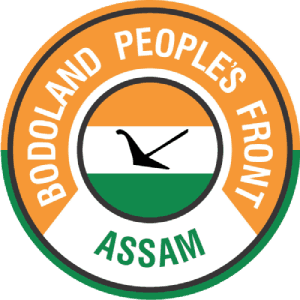



Formed in 2005, the Bodoland People’s Front (BPF) is a leading state-level political party in Assam built on principles of all round development of all sections of citizens of Bodoland as well as the State. Headquartered in the town of Kokrajhar, the BPF has been in power at the Bodoland Territorial Council (BTC) — comprising four districts of the state — since the first election of the Council held in 2005. Ideologically, along with upliftment of the population, BPF’s motto is to administer Bodoland and the state of Assam as a whole through the principles of democracy, socialism and secularism, with an eagle-eyed focus on eradication of poverty. In Assam, the BPF is a part of the Bharatiya Janata Party (BJP)-led alliance — the National Democratic Alliance (NDA) — which formed the Government in the state in 2016. The party is also a member of the regional political coalition named North-East Democratic Alliance or NEDA.
The origin of the Bodoland People’s Front (BPF) can be traced back to the erstwhile Bodo Liberation Tigers (BLT), which started as a volunteer movement in the year 1987 with a focused demand for a separate state of Bodoland. The movement was then formally drafted in 1988 under the leadership of Chairman Prem Singh Brahma and Secretary General Reo Reoa Narjihary. After years of struggle, in 1993 a pact signed between the Bodo Liberation Tigers (BLT) and the Central Government. In the presence of the then Minister of State for Home, late Rajesh Pilot, on 20th June 1993 an agreement pact was signed creating the Bodoland Autonomous Council (BAC). This led to the BLT movement being abandoned from 1993 to 1996. However, as the autonomy provided by the accord was largely just on paper, it failed, and the unfullfillment of promises by the then Central government led to the BLT being revived by Prem Singh Brahma in June 1996. On 18th June 1996, the BLT denounced the accord and revived its demand for a separate state for the Bodos.


Bir Chilagang Basumatary became the new Chairman of BLT with Hagarama Mohilary as the Military Secretary of the organisation with responsibility to manage the cadre. During the Kargil War between India and Pakistan in 1999, Mohilary declared a ceasefire and offered the Central government BLT troopers to fight for the country. Also, an amount of Rs 5 lakh was sent to support the Indian armed forces, which, however, was refused to be accepted by the Central government. Following to the declaration of the ceasefire in 1999, formal negotiations started between the Central government, then led by the Bharatiya Janata Party (BJP), and the BLT which culminated in an accord being signed on February 10, 2003. With Prime Minister Atal Bihari Vajpayee at the helm of the Centre, an accord with the BLT was signed in the presence of the then Deputy Prime Minister and Home Minister L K Advani and the then Assam Chief Minister, Tarun Gagoi. Post amendment of the Sixth Schedule of the Constitution of India, the tripartite agreement created the Bodoland Territorial Council (BTC), comprising four districts of Assam with sizeable Bodo population - Kokrajhar, Chirang, Baksa and Udalguri. The interim Council was run by Hagarama Mohilary from 2003-2005. The first election of the Council, held in 2005, was won by the then newly formed Bodoland People’s Front (BPF) with an absolute majority of 39 out of the 40 seats. Mohilary formed the first elected Executive Council of Bodoland Territorial Council (BTC). Later, in the elections held in 2010 for the 40 seats, the BPF retained power for the second term with a win in 29 seats. In the 2015 BTC elections the party registered victory for the third straight term with a win in 21 seats.


With a 3:2 size ratio, the tri-coloured flag of the Bodoland People’s Front (BPF) has a nangal (an indigenous plough) in black as a symbol at the centre of the white colour, signifying agricultural growth and the strength of the economy. While, the saffron colour at the top signifies courage and sacrifice for the cause of the nation, Bodoland as well as for Assam, the white band in the middle signifies truth, purity and peace and the green at the bottom signifies the faith and strength.